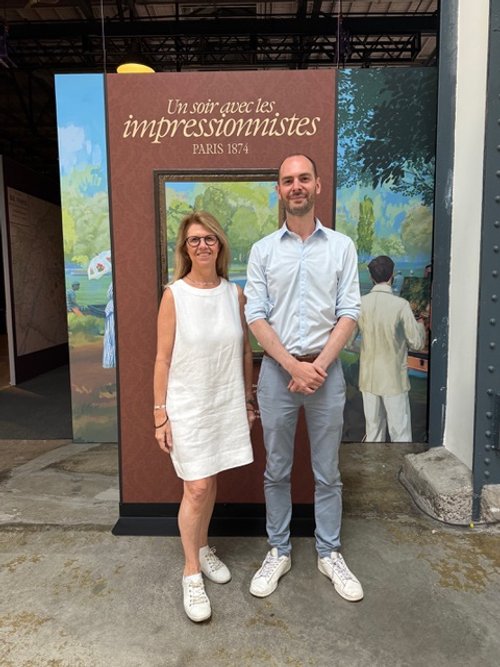How Immersive Experiences Are Redesigning Our Relationship with Reality
Immersive experiences are no longer mere spectacles — they are becoming strategic instruments to rewire attention, memory, and emotion. As the boundaries between physical and virtual dissolve, a new form of storytelling is emerging — one that can travel, adapt, and move people deeply. But how are these experiences designed? And what can visionary leaders learn from this rising art of presence?
Designing Wonder
They enter in silence, unsure of what awaits. Then, the world shifts. The light flickers. Walls dissolve. Suddenly, it is Paris in the spring of 1874. Through the eyes of Monet, Degas, Renoir, and Morisot, the visitor becomes a witness—almost an accomplice to the birth of Impressionism.
But this scene? You might have experienced it in Montreal. Or New York. Or Hong Kong. Or in a small provincial museum. Because Tonight with the Impressionists – Paris 1874 is not an exhibition! It’s an immersive experience — a world rebuilt to travel, a narrative ecosystem designed to circulate wherever there’s space to welcome it.
Behind this poetic leap lies a quiet revolution: new creators, such as Excurio and Gedeon Experiences, are reshaping how we tell stories and inhabit them. They turn history into presence, culture into movement, and emotion into architecture.
Today, the challenge is no longer to craft a narrative—it is to design a state of being. We must create immersive universes that people can walk through, feel, and remember. We must engage not only our eyes and ears, but also our memory, movement, and sense of wonder. One of the most refined examples of this new form is Tonight with the Impressionists – Paris 1874, a creation that bridges history and high technology with realistic precision. It invites us not only to observe, but to inhabit a moment in time — and to feel history from the inside out.
How are immersive experiences conceived, designed, and made to scale across minds, markets, and cultures?
🟡 From Ephemeral to Itinerant: Why Immersive Experience Is Becoming a Strategic Form
For centuries, cultural experiences were rooted in place: a fresco on a chapel ceiling, an opera in a concert hall, an exhibition within four walls. They were singular, often ephemeral — made to be encountered here, now, or never again. But as our society becomes increasingly nomadic, digital, and hyperconnected, a new kind of experience is emerging: the immersive format designed to travel.
Immersive experiences are no longer static installations — they are modular, mobile, and multisensory ecosystems. Designed to be deployed in different cities, adapted to various architectural contexts, and reinterpreted by diverse audiences, they blend the fluidity of cinema with the presence of theater and the interactivity of gaming.
What makes them strategic is not only their ability to generate awe, but their potential to scale emotion — to touch people across cultures through carefully choreographed storyworlds. In this sense, they are not just artistic gestures; they are tools of influence, vehicles of memory, and platforms for engagement.
At a time when attention is the rarest currency, immersive experiences hold it — and transform it. They invite the body back into the equation, reclaiming the spatial, sensory, and emotional dimensions often lost in screen-based interactions.
For innovators and decision-makers, this shift offers more than spectacle. It offers a new language to connect, educate, and inspire — one that speaks not only to the mind, but to the entire human sensorium.
Who are the architects of these multi-sensory realities?
Tonight with the Impressionists – Paris 1874 © Excurio - GEDEON Experiences - Musée d'Orsay
🟡 Anatomy of an Immersive Masterpiece: Tonight with the Impressionists – Paris 1874
Among the immersive experiences that have travelled across continents, "Tonight with the Impressionists – Paris 1874" stands out not just for its aesthetic brilliance but also for its narrative depth and technical elegance.
Co-produced by Gedeon Experiences, Excurio, and Musée d’Orsay, the project invites visitors into a reconstructed moment in history: the first Impressionist exhibition, reimagined in vivid, walkable virtual space. With VR headsets and spatial sound, participants move freely through a 19th-century Parisian salon, overhearing imagined conversations between Monet, Morisot, and Degas — while rediscovering the radical beauty of their paintings as they appeared then: new, misunderstood, and alive.
But what makes this experience so powerful isn’t just its technology. It’s the intentionality behind every choice: from the pacing of the visitor’s movement to the emotional weight of each scene. It is the result of a meticulous collaboration between historians, screenwriters, immersive designers, and technologists, all working toward a single goal — not to inform, but to immerse.
The experience becomes a time machine of perception. It does not explain Impressionism; it lets you feel its urgency. It does not simply teach history; it restores its emotional voltage.
From its modular set design to its scalable tech infrastructure, the project was conceived as a cultural object in motion. Whether presented in a museum in Paris, Montreal, or Hong Kong, it retains its narrative core while embracing local perception.
In this sense, it embodies a new generation of immersive storytelling — one that is not confined by geography or format, but designed for continuity, resonance, and movement.
🟡 Inside the Ecosystem: How Gedeon Experiences and Excurio Bring Immersive Worlds to Life
Co-producers of the immersive journey: Agnès Garaudel, General Manager and Producer at Gedeon Experiences. Fabien Baratti, CEO of Excurio, at the Montreal inauguration.
How does such immersion come to life? Behind every seamless immersive experience lies a complex weave of disciplines — historical research, dramaturgy, spatial design, interactive engineering, sound architecture, and real-time rendering — orchestrated into a coherent, emotionally resonant whole. Few collaborations embody this orchestration as powerfully as the one between Gedeon Experiences, Excurio, and the Musée d’Orsay.
Each partner brings distinct, complementary strengths. Gedeon, a pioneer in high-end documentary and cultural content, contributes decades of editorial depth and narrative craftsmanship. Its immersive branch — Gedeon Experiences — explores how emotion and fact can be staged to speak directly to the senses. Excurio, founded in 2020, specializes in free-roaming VR experiences that blend history, art, and science through advanced interactive design. The Musée d’Orsay brings curatorial excellence and historical authority, grounding the experience in rigorous research and cultural authenticity.
At the heart of this co-creation lies a shared philosophy: immersive storytelling must not merely impress — it must be lived.
The experience was shaped by three key producers:
🔹 Agnès Garaudel, General Manager and Producer at Gedeon Experiences, who guided the creative vision with precision and sensitivity, ensuring historical fidelity met emotional resonance.
🔹 Fabien Baratti, CEO of Excurio, whose background in immersive architecture and digital interaction helped anchor the technical framework of the experience.
🔹 The Musée d’Orsay, represented by curators Sylvie Patry and Anne Robbins, who provided scientific direction, overseeing the meticulous historical research and ensuring the authenticity of the reconstructed environments and narratives.
Together, they created an experience that is crafted to be portable without dilution, capable of delivering a profound sense of presence, whether you're in Paris, New York, or Hong Kong.
🟡 Beyond Immersion: Cultural Diplomacy, Education, and the Future of Presence
As the boundaries between art, memory, and innovation dissolve, immersive experiences begin to speak a new language — one that extends beyond spectacle to serve deeper purposes. The implications of such work extend far beyond culture and entertainment. As immersive experiences become more sophisticated, they are no longer confined to traditional museum settings or passive consumption. They are evolving into strategic instruments — tools for soft power, cultural transmission, and even collective healing.
Projects like Tonight with the Impressionists — Paris 1874 reveal how virtual presence can serve real-world goals: education, emotional literacy, historical empathy. When deployed internationally, they become ambassadors of memory, carrying with them not just content, but a sensibility — a way of seeing, feeling, remembering.
In an era of rising polarization and algorithmic fragmentation, these experiences offer a rare form of shared attention. Unlike passive media consumption, immersive journeys demand full presence. They invite visitors to walk through complexity, not just read about it. They make history tactile, and culture visceral.
This signals a new frontier for leaders in business, education, art or government. Immersive formats can be harnessed to transmit values, create trust, and ignite curiosity. They represent a move away from static messaging toward experiential engagement — a communication shift that is especially relevant in a world where facts alone no longer persuade.
But perhaps their most radical promise lies elsewhere.
In a time where so much is virtual, abstract, and disembodied, these experiences remind us that the future of innovation may depend not on escaping reality — but on redesigning our relationship to it.
Toward a New Language of Innovation
Immersive experiences aren’t just a trend — they’re a new language. One that fuses storytelling, technology, space, and emotion into forms that touch both individuals and communities.
For cultural institutions, they offer new paths to relevance.
For entrepreneurs and creatives, they open fertile ground for experimentation.
For leaders navigating complexity, they provide a blueprint for building resonance in an increasingly fragmented world.
What if you could design wonder?
Historian Yuval Noah Harari reminds us that humans are not only biological creatures; we are also story-driven. Fiction, he argues, is the glue that binds large-scale cooperation. In this light, immersive experiences are not escapism but the next evolution of narrative infrastructure, shaping the stories through which societies cohere, imagine, and act.
What story would you bring to life?
What story would you bring to life through an immersive experience? How could such a journey transform your organization’s connection with its audience?
References:
Tonight with the impressionists, Montreal, 2025
Excurio, immersive VR design and platform
GEDEON Experiences, cultural storytelling and immersive content
Centre PHI
You can also explore my article on the Montreal presentation of Tonight with the Impressionists — Paris 1874, presented by PHI Studio:
🔲 Paris 1874, at the heart of the Impressionist revolution - Read it on The Imaginary Notebooks


